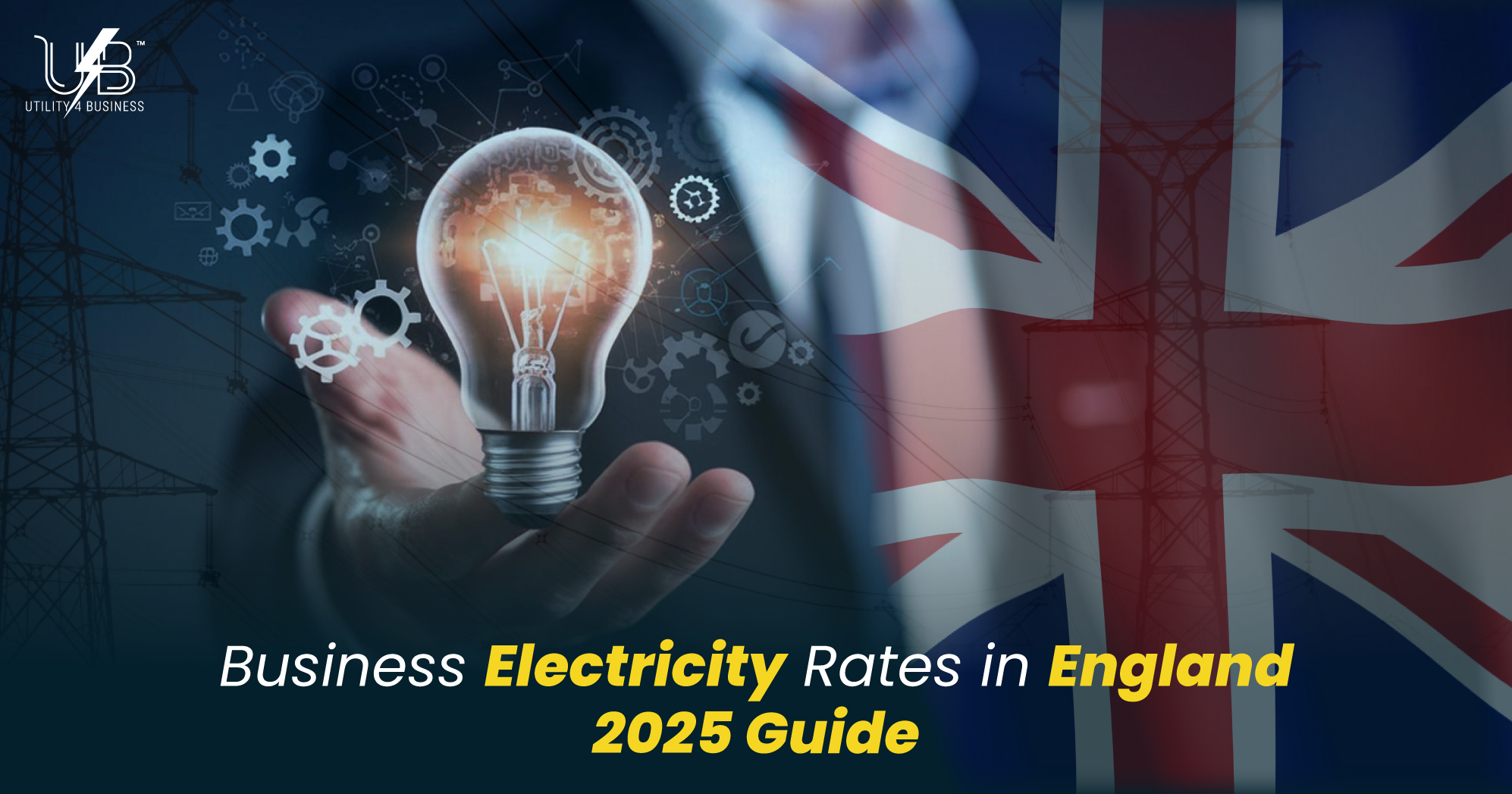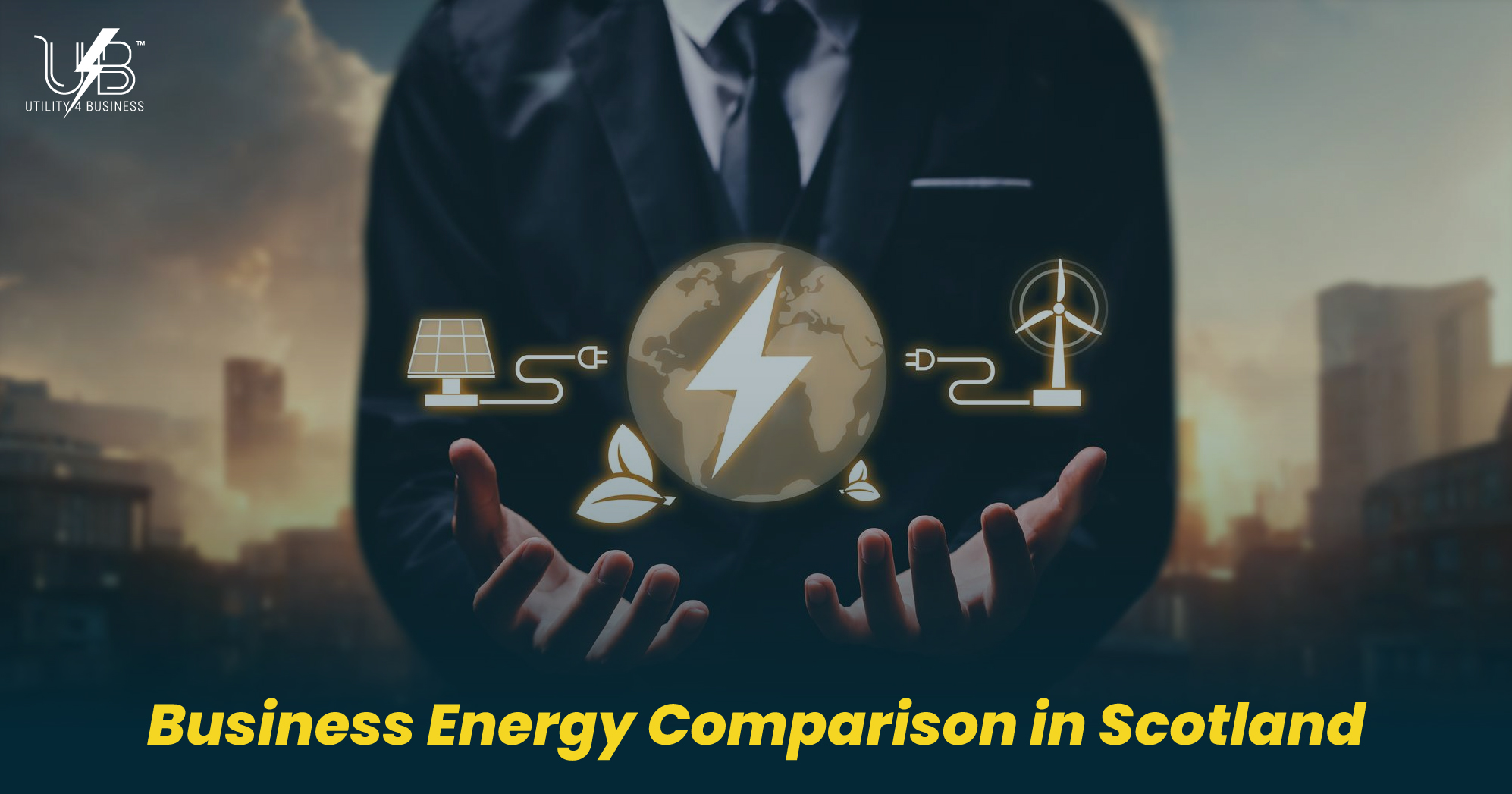Business Electricity Rates in England – 2025 Guide
Compare Business Electricity England Rates

Business electricity in England has settled from the shock of the 2022–23 spike, but costs still vary by contract type, timing, and how your site uses power. Many firms now face a higher share of fixed charges on their bills, while unit rates move with wholesale markets. Contract rules, taxes, and network fees add more layers. It is easy to miss savings or accept terms that do not suit your risk.
This guide explains the moving parts of English business electricity bills in 2025. You will learn how unit rates and standing charges work, which elements you can control, and how to compare offers on a like-for-like basis. You will also see practical steps to avoid costly “deemed” arrangements and common mistakes that inflate annual spend. At Utility4Business, we help companies across England secure clear, fair contracts and avoid hidden uplifts. We use data to shape decisions, not guesswork, so your business electricity comparison reflects your actual usage and site profile.
Throughout the guide, you will see natural use of key phrases that buyers search for, including business electricity England, business energy comparison England, Online Electricity Quotes, and wider operational needs such as Get Business Insurance in England. These reflect real queries and help you find answers that matter to your day-to-day operations.
How Business Electricity Billing Works
Every English business electricity bill rests on two core prices:
- Unit rate (p/kWh): the price for each kilowatt-hour consumed.
- Standing charge (p/day): a fixed daily cost to keep your site connected and covered by core network services.
Suppliers recover network and policy costs either inside the unit rate (bundled) or as itemised pass-through charges. Both structures are common and valid. What matters is clarity. When you compare offers, ensure you know which elements are fixed for the term and which can vary. Key components include:
- Network charges: costs for local distribution and the national transmission system.
- Balancing and system services: costs linked to keeping the grid stable.
- Environmental and social schemes: support for the energy transition and related programmes.
- Climate Change Levy (CCL): a government tax applied to business electricity consumption, with reliefs for eligible sectors under Climate Change Agreements.
- VAT: usually 20% for businesses, with a reduced 5% rate in limited cases (for example, very low usage or qualifying charitable non-business use).
Understanding these items helps you run a clean, competitive business electricity process where you judge total cost, not just a headline unit rate.
What Changed For 2025
Several developments shape English business bills this year:
- More Focus On Fair Treatment: Rules and guidance around the non-domestic marketplace should place more weight on clear pricing, accessible complaint routes, and visibility of any third-party fees. This helps micro and small businesses in particular.
- Standing Charges In The Spotlight: Network charging reform over recent years shifted more recovery to fixed-style charges, which is why standing charges can feel high even if unit rates fall. The aim is a more stable way to fund grid upgrades and maintenance. Businesses should now compare standing charges as carefully as unit rates.
- Metering and Legacy Controls: The radio teleswitch switch-off in mid-2025 pushed some legacy time-of-use meters and controls to be updated. If your off-peak periods or timers changed this year, confirm the new schedule and check that your bills match your actual usage pattern.
- Ongoing Grid Investment: Network upgrades and reinforcement continue to feed into non-energy costs over time. Budget for gradual pressure on fixed components, even when wholesale prices ease.
None of these changes prevents savings. They do, however, raise the bar for careful business electric comparison based on full-bill impact.
Contract Types And When To Use Them
Choosing the right contract is as important as the price you pay. In England, most firms meet four structures:
Fixed-Term, Fixed-Price
You fix the unit rate for 12, 24, or 36 months. Some offers also fix key non-energy elements. This gives strong budget certainty. It suits firms that value stable cash flow and prefer simple billing. If markets are climbing, a longer term can protect you; if markets are drifting down, a shorter term keeps you flexible.
Fixed With Pass-Through
The energy portion is fixed, while some non-energy costs move with published tariffs or regulatory changes. This can start cheaper than a full fix. It makes sense for businesses that monitor bills and want to benefit if certain charges are reduced. It introduces some month-to-month movement, so ensure your finance team is comfortable with that.
Flexible Or Portfolio
Larger users may buy power in tranches through the term. This can capture dips and spread risk. It needs a clear policy, strong governance, and timely decisions. If you lack the bandwidth to run active purchasing, a well-chosen fixed structure may deliver better results.
Deemed Or Out-Of-Contract
This applies when you move premises without a contract or allow your contract to lapse. Prices are higher by design. You can leave at any time once you sign a deal. Treat this as a stopgap only, and act quickly to avoid needless spending.
At Utility4Business, we look at your load shape, cash-flow needs, and market view. Then we recommend a structure that fits your risk and present a like-for-like business electricity comparison England pack.
Why Business Size And Profile Matter
Size affects both pricing and the protections you can access:
- Micro and Small Businesses: You benefit from clearer rules on contract terms, complaint routes, and the disclosure of fees charged by third-party intermediaries (TPIs). This reduces the risk of hidden uplifts and unfair terms.
- Medium And Larger Users: You have more options on pass-through and flexible purchasing. You also carry more exposure if bills are set up badly, so metering accuracy and capacity settings matter.
Load shape also drives cost. A site with sharp daytime peaks may pay more than a site with steady usage, even with the same annual kWh. Half-hourly data reveals these patterns and helps suppliers price accurately. It also lets you target actions such as shifting some processes to shoulder periods to improve your effective p/kWh.
What You Can and Cannot Control
You cannot steer the broad wholesale market or most regulated charges. You can control how, when, and what you buy and how you use electricity.
Outside Your Control
- Seasonal wholesale swings and global events
- Government-set taxes and levy rates
- Structural elements of network charging
Within Your Control
- Timing: Start renewal early. Markets move, and last-minute quotes tend to price in more risk.
- Term Length: Pick 12, 24, or 36 months to match your view and cash-flow needs.
- Contract Structure: Decide if you want full certainty or are comfortable with limited pass-through.
- Metering and Data: Capture interval data where possible. Fix metering issues at once.
- Operational Efficiency: Tidy scheduling and set-point control often save 5–15% without heavy capex.
- Site Changes: Tell your adviser about new equipment or shifts in hours before you tender, so quotes reflect reality.
Utility4Business builds these levers into every tender, so the business electricity comparison reflects your true conditions.
Taxes, Levies, And How To Check Them
Two lines on your invoice can move your effective price more than you think:
- VAT: Most businesses pay 20%. Some pay 5% if their usage sits within the de minimis threshold, or if the supply is for qualifying charitable non-business use. This is a strict test, so check the rules and keep the right declarations on file.
- Climate Change Levy (CCL): This is charged per kWh on business electricity. Firms with a Climate Change Agreement can receive a significant discount on the levy. Confirm that relief is applied, and keep evidence up to date.
These items are not optional, but they are often misapplied. Check them when you sign and on every bill.
Standing Charges: Why They Matter In 2025
Standing charges now carry a larger slice of the total cost for many SMEs. This shift reflects changes in how networks recover fixed costs. The effect is simple: a low unit rate does not guarantee a low bill if your standing charge is high. During the comparison of business electricity exercises:
- Insist on seeing the standing charge for each quote.
- Review any capacity charges or extra metering fees.
- Remove obsolete meters and avoid paying for unused supplies.
- If you have more than one site, compare standing charges across regions. Different distribution areas have different cost bases.
Not every supplier will be the cheapest on both unit rate and standing charge. Judge the whole-bill impact using your consumption profile.
England-Specific Practical Points
While England shares the Great Britain market with Scotland and Wales, a few points are worth noting:
- Regional Differences: Distribution zones set the context for certain charges. Two English sites with similar usage can pay different standing charges because of local network costs.
- Urban Load Patterns: Many English city sites peak on weekday days. If that is you, request quotes that reflect your time-of-use pattern and explore load management to clip peaks.
- Moving Premises: Arrange contracts before you take over a site to avoid automatic deemed rates. Confirm meter details, energisation status, and any change-of-tenancy steps in advance.
Utility4Business manages these steps as part of business energy comparison in England, so suppliers model your site correctly from day one.
How To Read A Quote (And Spot Gaps)
When suppliers or advisers present offers, ask for a simple structure:
- Contract Type and Term: State fixed, fixed with pass-through, or flexible, and the exact length.
- Unit Rate: p/kWh, with any time-band detail if relevant.
- Standing Charge: p/day.
- Non-Energy Costs: Which elements are fixed and which are pass-through?
- Taxes and Levies: VAT rate assumed and how CCL is treated.
- Third-Party Fees: Written disclosure of any TPI uplift or fee.
- Credit and Security: Deposits, direct debit, or other terms.
- Metering Assumptions: Half-hourly vs non-half-hourly, profile class, and expected annual quantity.
If the quote bundles everything into one unit rate, ask the supplier to confirm what is included. If costs are pass-through, ask for a worked example using last year’s usage so your business electricity comparison remains fair.
Deemed And Out-Of-Contract Rates: Act Fast
Deemed rates keep the lights on when you have no contract, but the premium price is there on purpose. If you move premises or your deal ends, contact the supplier at once and ask for a short-term fix while you run a proper tender. Even a few weeks on deemed rates can undo savings you worked hard to achieve.
Utility4Business prioritises fast removal from deemed arrangements. We prepare Online Electricity Quotes the same day in most cases and present them in a like-for-like format, so you can sign with confidence.
Running A Clean Tender: A 10-Step Method
Use this method to keep control and cut risk:
- Gather 12–24 Months Of Data: Monthly kWh totals and, if available, half-hourly data.
- Confirm Meter And Capacity Details: MPAN, profile class, available capacity, and any time-of-use settings.
- Set Risk Preferences: Choose your target term and decide whether you accept pass-through.
- Confirm Sustainability Position: Renewable certificate treatment, on-site generation, and any CCA status.
- Check VAT and CCL: Confirm your VAT rate and any levy relief before you tender.
- Invite Multiple Suppliers: Use a clear template that requests both unit rate and standing charge.
- Demand Fee Disclosure: Get any TPI uplift or fixed fee in writing.
- Compare Whole-Bill Impact: Model quotes against your actual load shape and standing charge.
- Review Legal Terms: Termination rights, rollovers, credit clauses, and moving-premises steps.
- Diarise Renewal: Set reminders 120 days before the end date to avoid a default into deemed rates.
Utility4Business handles each step and reports results in an “apples-to-apples” business electricity comparison sheet. We also coordinate Online Electricity Quotes so you can execute on time.
Efficiency Wins That Do Not Disrupt Operations
You can often lower effective p/kWh without big projects:
- Scheduling: Align equipment run-times with working hours and avoid idle overnight loads.
- Set-Point Control: Tighten heating and cooling set-points and maintain equipment.
- Lighting: Use LED and smart controls in offices, corridors, and yards.
- Variable Speed Drives: Fit to motors and fans where cycles allow.
- Maintenance: Poor power factor and failing equipment waste energy and shorten asset life.
These actions support compliance targets and signal good practice to insurers and landlords. If you plan to Get Business Insurance in England, clean operational controls can help you present lower risk.
Using The Web Wisely (And Avoiding Traps)
Online averages can mislead because they ignore your region, meter type, or load shape. Use the web to check rules and definitions rather than to set your budget:
- VAT rates and the de-minimis threshold for the 5% rate
- Climate Change Levy rates and reliefs
- Business contract guidance, moving-premises steps, and deemed contract rules
- Background to network charging reform and why standing charges have risen
Then run a tender that reflects your own data. Utility4Business turns those rules into a practical plan and prices it against your site profile.
How Utility4Business Helps
- Fast, Clear Quotes: We gather your data, fix metering issues, and deliver like-for-like options.
- Bill Certainty: We advise on the right term and structure so your cash flow stays stable.
- Regulatory Hygiene: We check VAT and CCL on every quote and after you sign.
- End-To-End Support: We diarise renewals, handle change-of-tenancy steps, and help you avoid deemed rates.
- Broader Needs: We can integrate gas, water, waste, and introductions for Get Business Insurance in England into the same planning calendar.
If you want action today, ask us for Online Electricity Quotes. We will prepare an apples-to-apples business electricity comparison pack that reflects your usage, region, and risk stance.
Conclusion
Business electricity rates in England in 2025 hinge on more than a low unit rate. Standing charges now carry more weight, and taxes and levies can shift your true cost. The right contract structure, term length, and timing of purchase matter. So do metering accuracy, operational discipline, and early renewal.
Start with clean data. Decide how much price movement you can accept. Compare offers on a like-for-like basis, including standing charges and any pass-throughs. Check VAT and CCL from the outset. Avoid deemed rates, and plan ahead when you move premises or approach renewal.
Utility4Business is ready to help you do exactly that. We deliver business electricity England expertise, complete business energy comparison England support, and fast Online Electricity Quotes that you can trust. With a disciplined process and clear terms, you can keep costs under control and focus on your core work, not your power bill.
Find This Article Helpful? Share It Now!
At Utility4Business, we offer top-notch customer support and business utility solutions for businesses across the UK. Consider sharing this article and helping others discover how our expertise can add value to their business success.

Read Our Latest Posts
Explore our latest blog posts and learn how Utility4Business can support your business growth with tailored utility solutions and services. Stay ahead of the curve with the latest information from industry experts and take advantage of our user-friendly comparison services to find the best business deals.


Get Connected
At Utility4Business, our team of experts can help you figure out the highest-value business utility deals that will help your business grow over time.

